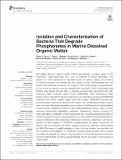| dc.contributor.author | Sosa, Oscar A. | |
| dc.contributor.author | Ferrón, Sara | |
| dc.contributor.author | Bryant, Jessica A. | |
| dc.contributor.author | Mende, Daniel R. | |
| dc.contributor.author | Karl, David. M. | |
| dc.contributor.author | DeLong, Edward F. | |
| dc.contributor.author | Repeta, Daniel | |
| dc.date.accessioned | 2018-06-21T15:03:24Z | |
| dc.date.available | 2018-06-21T15:03:24Z | |
| dc.date.issued | 2017-09 | |
| dc.date.submitted | 2017-06 | |
| dc.identifier.issn | 1664-302X | |
| dc.identifier.uri | http://hdl.handle.net/1721.1/116474 | |
| dc.description.abstract | Semi-labile dissolved organic matter (DOM) accumulates in surface waters of the oligotrophic ocean gyres and turns over on seasonal to annual timescales. This reservoir of DOM represents an important source of carbon, energy, and nutrients to marine microbial communities but the identity of the microorganisms and the biochemical pathways underlying the cycling of DOM remain largely uncharacterized. In this study we describe bacteria isolated from the North Pacific Subtropical Gyre (NPSG) near Hawaii that are able to degrade phosphonates associated with high molecular weight dissolved organic matter (HMWDOM), which represents a large fraction of semi-labile DOM. We amended dilution-to-extinction cultures with HMWDOM collected from NPSG surface waters and with purified HMWDOM enriched with polysaccharides bearing alkylphosphonate esters. The HMWDOM-amended cultures were enriched in Roseobacter isolates closely related to Sulfitobacter and close relatives of hydrocarbon-degrading bacteria of the Oceanospirillaceae family, many of which encoded phosphonate degradation pathways. Sulfitobacter cultures encoding C-P lyase were able to catabolize methylphosphonate and 2-hydroxyethylphosphonate, as well as the esters of these phosphonates found in native HMWDOM polysaccharides to acquire phosphorus while producing methane and ethylene, respectively. Conversely, growth of these isolates on HMWDOM polysaccharides as carbon source did not support robust increases in cell yields, suggesting that the constituent carbohydrates in HMWDOM were not readily available to these individual isolates. We postulate that the complete remineralization of HMWDOM polysaccharides requires more complex microbial inter-species interactions. The degradation of phosphonate esters and other common substitutions in marine polysaccharides may be key steps in the turnover of marine DOM. | en_US |
| dc.description.sponsorship | Gordon and Betty Moore Foundation (Award GBMF3298) | en_US |
| dc.description.sponsorship | Simons Foundation (Grant 329108) | en_US |
| dc.publisher | Frontiers Research Foundation | en_US |
| dc.relation.isversionof | http://dx.doi.org/10.3389/FMICB.2017.01786 | en_US |
| dc.rights | Creative Commons Attribution 4.0 International License | en_US |
| dc.rights.uri | http://creativecommons.org/licenses/by/4.0/ | en_US |
| dc.source | Frontiers | en_US |
| dc.title | Isolation and Characterization of Bacteria That Degrade Phosphonates in Marine Dissolved Organic Matter | en_US |
| dc.type | Article | en_US |
| dc.identifier.citation | Sosa, Oscar A. et al. “Isolation and Characterization of Bacteria That Degrade Phosphonates in Marine Dissolved Organic Matter.” Frontiers in Microbiology 8 (September 2017): 1786 © 2017 The Authors | en_US |
| dc.contributor.department | Massachusetts Institute of Technology. Department of Earth, Atmospheric, and Planetary Sciences | en_US |
| dc.contributor.department | Woods Hole Oceanographic Institution | en_US |
| dc.contributor.mitauthor | Repeta, Daniel | |
| dc.relation.journal | Frontiers in Microbiology | en_US |
| dc.eprint.version | Final published version | en_US |
| dc.type.uri | http://purl.org/eprint/type/JournalArticle | en_US |
| eprint.status | http://purl.org/eprint/status/PeerReviewed | en_US |
| dc.date.updated | 2018-06-20T18:45:41Z | |
| dspace.orderedauthors | Sosa, Oscar A.; Repeta, Daniel J.; Ferrón, Sara; Bryant, Jessica A.; Mende, Daniel R.; Karl, David. M.; DeLong, Edward F. | en_US |
| dspace.embargo.terms | N | en_US |
| mit.license | PUBLISHER_CC | en_US |
